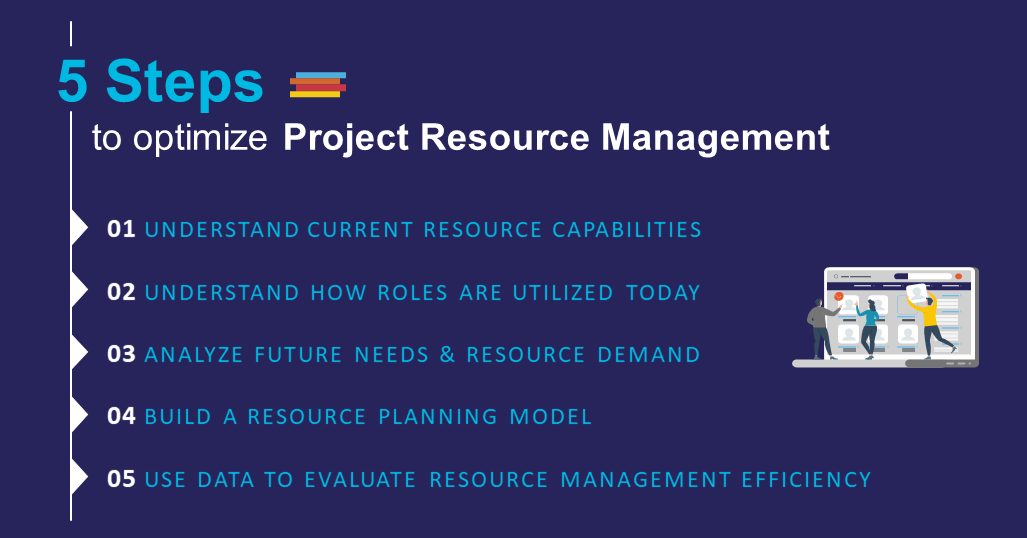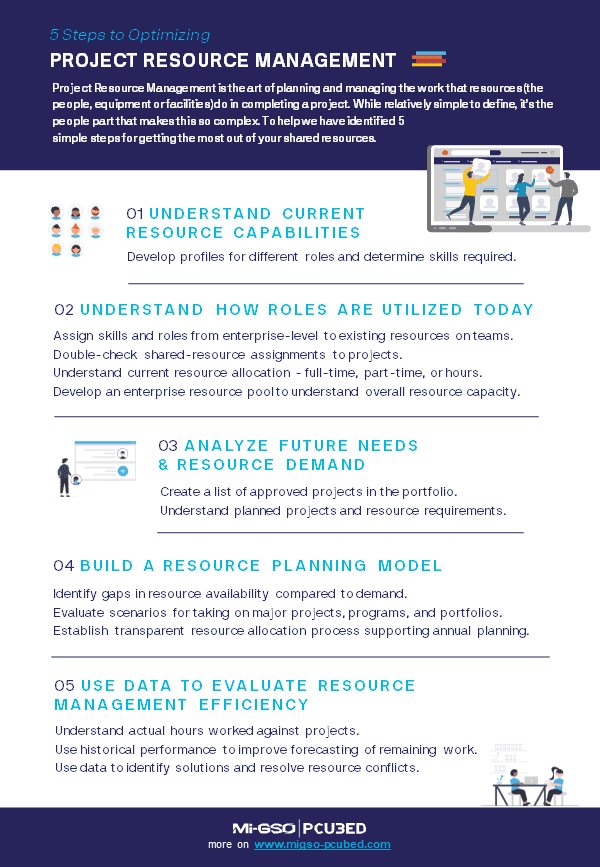Our website is not supported on this browser
The browser you are using (Internet Explorer) cannot display our content.
Please come back on a more recent browser to have the best experience possible

Project Resource Management is the art of planning, allocating, managing, and measuring the work that people do in order to complete a project. Project “resources” could be the people, equipment, facilities, or anything else needed to get work done. It is relatively simple to define, however, it’s the people part of the resource equation that makes this one of the most complex operations for businesses to manage.
Done well, it can make a huge difference to a company’s bottom line. It can promote sustainable growth, increase ROI and time to market, and ensure complicated projects are delivered on time and on budget. Done badly, and well you know the statistics on failed projects. This is one of the biggest PPM challenges faced by teams today – especially as more organizations adopt Agile team-based work and one we were happy to help our client address.
Our client, a global Pharmaceutical Manufacturer, maintains a vast portfolio of projects running concurrently across several departments. These projects include R&D, Equipment Qualification, IT Implementations, Construction, and even new methods development. Common in large organizations, they utilize a shared resource pool to deliver their projects.
Over time, projects had started to slip as key resources either weren’t available or were getting reassigned elsewhere. This caused milestones to be delayed, ranging anywhere from two months up to even a year. Our client wanted to take a more focused look at resource management in project management to improve their ability to deliver on current and future initiatives. As such, our client reached out to us to help them improve their existing Resource Management processes and to implement a Resource Management Office (RMO).
We at MIGSO-PCUBED have worked with many companies over the years to implement integrated capacity planning and to resolve challenges related to resource demand management. The key is establishing visibility on resource demand against available capacity and ensuring data quality; two places where a Resource Management Office can help.
Separate Resource Management Offices have been rising in popularity over the past few years as organizations have attempted to deal with the increasing complexity of managing resources. This increase is due in part to the global nature of projects as well as the highly specialized skills required in an industry like pharmaceuticals. Additionally, the influx of hybrid and remote work introduced by COVID-19, and of course Agile team-based work, has required organizations to rethink what constitutes effective resource management.

The team began by identifying the role that Resource Management would play within the organization and how they could work to improve the existing processes. The core role of a Resource Management Office (RMO) is to gain and provide intelligence around the allocation, management, and utilization of resources within an organization.
Our client needed the ability to understand what types of resources they had today, as well as the ability to forecast future resource needs, to support strategic planning and budgeting. Essentially they needed to understand the current state of the organization’s demand vs. capacity.
A framework for Project Resource Management had already been defined covering its three main aspects – resource demand, capacity, and utilization. The implementation of this, however, was still not clear.
What stops organizations from being able to answer these seemingly simple questions comes down to a couple of common obstacles. Data around project resources is stored inconsistently, and processes for resource management are used inconsistently.
Data around project resources is stored inconsistently, and processes for resource management are used inconsistently.
The RMO needed to develop processes for resource planning and resource allocation to resolve conflicts and confusion around the shared resource pool.
There are 5 key steps an RMO would use in implementing project resource management. Their “success” lies in going back to the basics and ensuring that each step has been appropriately configured and optimized for the client’s specific environment and what they are trying to achieve.
Develop profiles for different roles and determine skills required.
Assign skills and roles from enterprise-level to existing resources on teams.
Double-check shared-resource assignments to projects.
Understand current resource allocation – full-time, part-time, or hours.
Develop an enterprise resource pool to understand overall resource capacity.
Create a list of approved projects in the portfolio.
Understand planned strategic projects and their potential resource requirements.
Evaluate scenarios for taking on major projects, programs, and portfolios.
Identify gaps in resource availability compared to demand.
Establish a transparent resource allocation process supporting annual planning.
Understand actual hours worked against projects
Use historical performance to improve future forecasting of remaining work.
Use resource management data to identify solutions to resolve resource conflicts.

To start, the team met with the various project leaders to understand the projects that were in flight and the resources required to complete those projects.
One challenge is that you have both central service resources and project dedicated resources. The client needed to be able to identify those team members who were able to handle project-specific work. In addition, they needed to then identify the necessary skill sets or capabilities required to deliver the projects within the pipeline. Take quality control for example – you need people that have quality control skills of course, but also chemistry, biostatistics, quality validation, and a lot more.
The capabilities data needed a lot of clean-up to ensure that it was properly captured within the resource management tool. The team utilized a combination of Excel, Power Query, data extraction, and manipulation to highlight and then resolve key data issues within the core system of record.
Second, in order to obtain an accurate handle on capacity, the department needed to optimize its process for tracking time. As a Planisware partner, our resource management experts were able to quickly jump in to help the client with their existing enterprise resource management software. The team reconfigured the time tracking processes by engaging with key stakeholders in their pilot. They began their initial rollout in February which proved quite successful, rolling it out to additional teams a few short months later.
The client now has actual data between the estimated versus actual capacity of the team and the demand of the team. With better data comes the ability to make better decisions. The RMO is now able to highlight important questions to ask, which leads to better forecasting. “Initially you said you needed 2 FTEs but you actually only have 1 FTE. Did you overestimate the capacity or do you really need an additional resource?”
The focus on the first steps – understanding the current capabilities and understanding how resources are being used – helped everyone go from ambiguity to certainty around what the actual demand for resources was. It provided the team with a zoomed-in view of resource management within the organization.
The next big challenge was identifying resource bottlenecks, i.e. which teams couldn’t keep up with demand. For the client, it wasn’t that resources hadn’t been allocated. It was the fact that the organization was utilizing shared resources to complete work across multiple projects. The individual project schedules did not take into consideration the other work that the resource already had in their queue. The RMO needed to establish a process for evaluating resource utilization and resource allocation at the portfolio level.
Fortunately, enterprise resource management tools provide users the ability to run scenarios around resolving resource bottlenecks. The RMO was able to quickly identify who would be affected and then worked to free up resources, using what-if analysis to put resources against activities that were of strategic importance.
While tools often have resource leveling capabilities embedded, it doesn’t account for the lost efficiency in moving resources back and forth between tasks or projects. Our consultants utilize a long-term view on resource management planning. The RMO can look at a specific resource role and then track how that person is to be scheduled each month up to seven years in the future.
In this, the client now knows when and where their people could be reassigned to minimize interruptions to inflight projects. If anyone needs to be shifted, the issue can be resolved far in advance – allowing their people to keep momentum on projects and get them done.
In total, the client has launched three resource management offices across their organization as they have looked to improve their project resource management capabilities.
One key objective was the ability to see at least 3 months into the future to identify any potential resource bottlenecks. The individual RMOs have built out resource plans for the next 18 months giving the team the ability to prevent issues well before they happen.
In addition, with their resources properly optimized, the client has been able to reduce their reliance on external contractors, shifting that work over to internal teams. This saved the business a sizable amount of costs just by using their own employees’ time better.
With resource forecasting solidified, the resource management offices have moved on to the next improvement phase – improving how new projects are introduced in the organization as well as providing scenarios on how to develop the best budget for the next fiscal year.
More on the same subject

← Check out our infographic summary of this article on Pinterest!
Loved what you just read?
Let's stay in touch.
No spam, only great things to read in our newsletter.
We combine our expertise with a fine knowledge of the industry to deliver high-value project management services.
MIGSO-PCUBED is part of the ALTEN group.
Find us around the world
Australia – Canada – France – Germany – Italy – Mexico – The Netherlands – Portugal – Romania – South East Asia – Spain – Switzerland – United Kingdom – United States
© 2024 MIGSO-PCUBED. All rights reserved | Legal information | Privacy Policy | Cookie Settings | Intranet
Perfect jobs also result from great environments : the team, its culture and energy.
So tell us more about you : who you are, your project, your ambitions,
and let’s find your next step together.
Dear candidates, please note that you will only be contacted via email from the following domain: migso-pcubed.com. Please remain vigilant and ensure that you interact exclusively with our official websites. The MIGSO-PCUBED Team
Choose your language
Our website is not supported on this browser
The browser you are using (Internet Explorer) cannot display our content.
Please come back on a more recent browser to have the best experience possible
